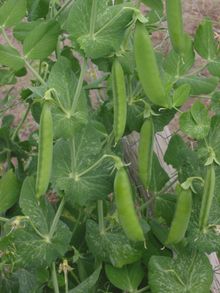Raffinose
| Structural formula | |||||||||||||||||||
|---|---|---|---|---|---|---|---|---|---|---|---|---|---|---|---|---|---|---|---|

|
|||||||||||||||||||
| General | |||||||||||||||||||
| Surname | Raffinose | ||||||||||||||||||
| other names |
|
||||||||||||||||||
| Molecular formula | C 18 H 32 O 16 | ||||||||||||||||||
| Brief description |
colorless prisms |
||||||||||||||||||
| External identifiers / databases | |||||||||||||||||||
|
|||||||||||||||||||
| properties | |||||||||||||||||||
| Molar mass | 504.46 g mol −1 | ||||||||||||||||||
| Physical state |
firmly |
||||||||||||||||||
| Melting point |
80–82 ° C (pentahydrate) |
||||||||||||||||||
| solubility |
|
||||||||||||||||||
| safety instructions | |||||||||||||||||||
|
|||||||||||||||||||
| As far as possible and customary, SI units are used. Unless otherwise noted, the data given apply to standard conditions . | |||||||||||||||||||
Raffinose is a carbohydrate that occurs in plants , more precisely a triple sugar ( trisaccharide ). It is made up of the three simple sugars galactose , glucose and fructose . It is a non-reducing sugar, as no ring opening is possible.
Occurrence and function


Raffinose and the raffinose family replace starch as a storage carbohydrate in some plants. Raffinose is found in large quantities in legumes . In peas and beans they can make up 5 to 15% of the dry matter. Raffinose is also found in sugar cane and sugar beet , but it accumulates in molasses during sugar production . In some species ( cucurbits , linden , elm ), raffinose is used instead of sucrose as a transport substance in the phloem's sieve tubes .
biosynthesis
The biosynthesis in plants takes place by transferring a galactosyl residue from galactinol to sucrose , whereby myo - inositol is released.
- Sucrose + galactinol → raffinose + myo-inositol.
This reaction is catalyzed by a myo-inositol-galactosyl-transferase. The galactose is attached in an α-1,6-glycosidic bond and the result is α- D- galactopyranosyl- (1 → 6) -α- D -glucopyranosyl- (1 → 2) -β- D -fructofuranoside.
Analytics
The reliable qualitative and quantitative determination of the raffinose succeeds after sufficient sample preparation and derivatisation as trimethylsilyl derivatives by coupling the gas chromatography or HPLC with the mass spectrometry .
Raffinose family
Two further oligosaccharides are derived from raffinose , to which further galactose units are attached in the same way, starting from raffinose in an α-1,6-glycosidic bond:
- Raffinose + galactinol → stachyose + myo-inositol,
- Stachyosis + galactinol → verbascose + myo-inositol.
Therefore, raffinose, stachyose and verbascose are also referred to as the raffinose family.
The compounds have the following molar masses :
- Raffinose: 504.5 g mol −1
- Stachyosis: 666.6 g mol −1
- Verbascose: 828.7 g mol −1
human
Raffinose has only 22% of the sweetness of beet sugar (sucrose) , as saccharides become more and more tasteless as the degree of polymerization increases.
In the small intestine it is only broken down and absorbed to a small extent, since the α-galactoside bond cannot be broken down by human digestive enzymes. As a result, larger amounts reach the large intestine . The anaerobic microorganisms of the intestinal flora present there utilize them and, among other things, produce gases that lead to flatulence .
literature
- Hans W. Heldt , Birgit Piechulla: Plant biochemistry . 4th edition. Spektrum Akademischer Verlag, Heidelberg 2008, ISBN 978-3-8274-1961-3 , pp. 252-253.
Web links
Individual evidence
- ↑ a b c d e Entry on raffinose. In: Römpp Online . Georg Thieme Verlag, accessed on December 25, 2014.
- ↑ a b c data sheet raffinose from Sigma-Aldrich , accessed on June 15, 2011 ( PDF ).
- ↑ Z. Füzfai, I. Boldizsár, I. Molnár-Perl: Characteristic fragmentation patterns of the trimethylsilyl and trimethylsilyl-oxime derivatives of various saccharides as obtained by gas chromatography coupled to ion-trap mass spectrometry. In: J Chromatogr A. 1177 (1), Jan 4, 2008, pp. 183-189. PMID 18061601
- ↑ MI Perlné, K. Horváth, Z. Katona: The possibilities of GC / MS and HPLC in the analysis of sugars and acids in natural matrices. In: Acta Pharm Hung. 70 (3-6), Jul-Dec 2000, pp. 231-238. PMID 11379030
- ^ Hans-Dieter Belitz, Werner Grosch, Peter Schieberle: Textbook of food chemistry. 6., completely revised Edition. Springer, Berlin 2008, ISBN 978-3-540-73201-3 , p. 263.